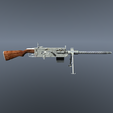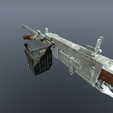The privately customized weapon used by the hero, I have made it into two modes: installing ammunition and dismantling ammunition, with a magazine attached. Choose one that you like to pay tribute to the hero
The "Stinger" was a customized field modification of the .30-caliber AN/M2 aircraft machine gun. The Stinger was a man-portable modification of the AN/M2 — primarily mounted by various contemporary US aircraft — to provide additional firepower to a platoon. A handful of these weapons were used during the Pacific Theater of World War II. Nicknamed as such due to its extremely high rate of fire which led to the weapon having "quite a sting",[4] most of the Stinger's fame comes from its use by Medal of Honor awardee Corporal Tony Stein, who used it during the Battle of Iwo Jima to provide covering fire for his platoon mates.[5] While often attributed as Stein's work, the Stinger was actually the brainchild of two marines, namely Sergeant Milan "Mel" J. Grevich[1] and Private First Class John Lyttle.[2][3]
History
The beginnings of the Stinger go back to at least 1943, where various Marines attempted to convert the AN/M2 aircraft machine gun, known for its very high rate of fire, into something that could be practically fielded in an attempt to provide additional firepower to troops of the time. The first known attempt at doing so was by Pvt. William "Bill" H. Colby of Gloversville, New York as part of the Bougainville Campaign where AN/M2 machine guns were carried ashore and put in fixed firing positions to defend Bougainville Island.[citation needed] What Colby did was rather simple; he simply fitted a bipod onto the muzzle of his AN/M2, ensuring a weapon that could be somewhat practically used on the field even with its awkward spade grips. Colby's creation was used just two days after the start of the campaign when he was ambushed by Japanese soldiers; Colby immediately deployed his modified gun. Being fed .30-06 rounds by assistant gunner Pvt. Edward F. Crumlish, Colby managed to repel the attack. While a decent design, the concept had to be improved, leading to more attempts being made to refine the concept. Two Marines, Sgt. Milan "Mel" J. Grevich and PFC John Lyttle, would later design an improved variation of the concept by taking steps and measures to make the weapon a more man-portable and legitimately usable machine gun; with these modifications, the Stinger was born. Grevich, was later reassigned to the machine gun section of G Company, 28th Marine Regiment, 5th Marine Division after his parachute division was disbanded after the Bougainville Campaign.[citation needed] Disappointed with the performance of his comrades' machine guns, he wanted to produce something that could remedy that; it was at that time when he remembered his Stinger prototype and set about recreating the gun. Grevich recreated six Stingers in total before sailing towards Iwo Jima.
Of the six guns, one was assigned to each of G Company's three rifle platoons, another to the company's demolitions section, and the fifth carried by Grevich. The sixth was carried by Cpl. Tony Stein from A Company, 28th Marines.[5] Stein used his Stinger to provide covering fire for his platoon mates and purposefully exposed himself to reveal enemy pillboxes and emplacements, eventually gunning them all down. Even though his Stinger was shot out of his hands twice by enemy fire,[6] Stein still managed to gun down a considerable amount of enemy infantry;[4] he would eventually be killed in action on 1 March 1945 by an enemy sniper while leading his platoon on a mission to infiltrate a number of pillboxes and would receive the Medal of Honor posthumously for his actions.[7]
After the war, most of the six Stingers were presumably destroyed most likely due to the US Army not liking to keep stock of nonstandard equipment, the Stinger being a prime example of that.[5] Despite none of the original six weapons surviving today, their legacy remains, with its legacy still being used to inspire young marines that the most capable weapon they have is their mind and coupled with courage can overcome any challenge.[3]
I have set them to a 1:35/1:72 ratio for easy printing, and the size comes from the data provided by the encyclopedia. You can adjust its size to any place by yourself.
Note: If using the model for 3D printing, model repairs may be needed.






















